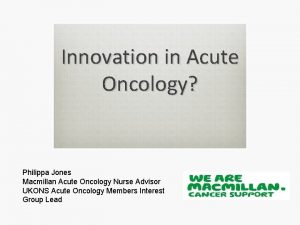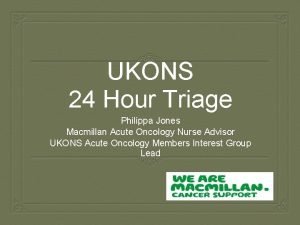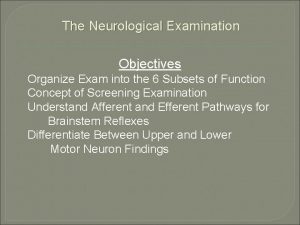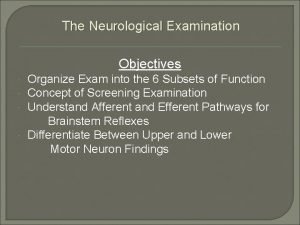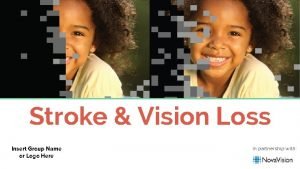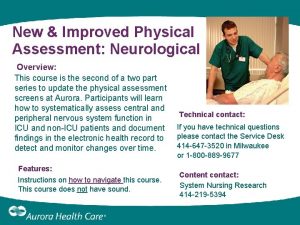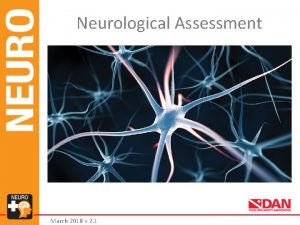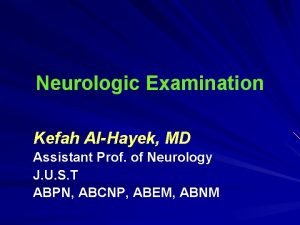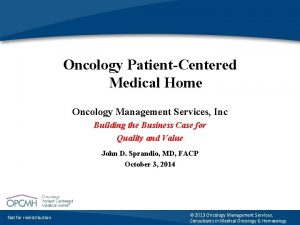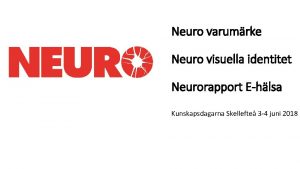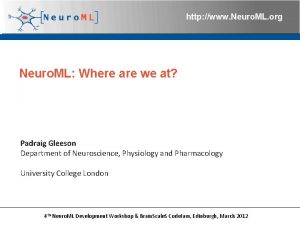Neuro Oncology Therapy Update Acute therapy services at










- Slides: 10

Neuro Oncology Therapy Update Acute therapy services at Southmead

Current Service • Ward based and primarily post-operative • Holistic assessment of: • Function • Physical performance • Cognition / communication / mood • Physio, OT, SLT, neuropsychology (on request) Anticipate needs on hospital discharge Highlight areas of vulnerability Highlight areas of potential for improvement (could be remedial or compensatory) Identify patient and family awareness of condition, prognosis etc. Inform MDT of assessment outcomes to enable treatment decision making

Current Service • Therapy treatment: • Education for patient and family (e. g. management of cognitive impairment, strategies to manage visual/functional deficits). At present, this education focuses primarily on short term management (immediately post discharge). • Onwards referrals and liaison with community services to support discharge planning. • Provision of necessary equipment for discharge. • Rehabilitation as resource allows.

Current Service • SLT pre-operative input: SLT currently assess and prepare people who have been identified as suitable for awake craniotomy including language mapping. There is an identified need for this to be developed across the MDT to facilitate discharge and manage expectations.

Post discharge therapy pathways • Patients cover a wide geographical area • Inpatient rehabilitation pathways: • Challenging for high grade tumours • Specialist versus generic • Lengthy waiting lists (patients often waiting for weeks for a bed, either locally or in their own DGH) • Not always able to access these pathways directly (e. g. Somerset)

Post discharge therapy pathways • Community / outpatient services: • Highly variable dependent on postcode • Often lengthy waiting lists due to resources • Consideration of health + social services, charitable organisations that offer services • Current example of Bristol / South Glos residents Discharge to assess (D 2 A): Pathway 1 (home with support), Pathway 2 (bedded rehabilitation), Pathway 3 (care home),

Areas of potential improvement: • Pre-operative input • More intensive resource to enable rehabilitation in the acute setting • Post-operative follow up • Anticipated benefits: • Improved quality of patient journey through pre-op, admission and post-operative care (with consideration of low grade tumours as long term neurological conditions) • Reduced length of stay for acute admissions

Pilot Proposal: • Pre-operative therapy involvement: • • One session per week of clinical time One session per week of non-clinical time (follow up referrals etc) Involvement of PT, OT, SLT (rotational) Completion of multidisciplinary therapeutic assessment with the option of contacting specific disciplines if specialist concerns highlighted. • Patients to be identified by basic screening tool for medics or specialist nurses: • Location of tumour indicates likely functional impairment • Pre-operative symptoms identified with: • Power/sensation • Swallow • Communication • Cognition • Complex discharge planning needs identified (e. g. comorbidities, social circumstances)

Pilot Proposal: • Plan to run for 3 – 6 months (dependent on data collection) • Plan to use current screening tool to identify appropriate patients and collect data for relevant patients prior to starting pilot. • Data to be collected: • Length of stay • Satisfaction questionnaire • QOL outcome measure (considering FACT-Q) • Ultimately the aim would be to complete a business case if pilot demonstrates good outcomes, with the option of expanding the service further. • Actions to date: • Discussions with community services and agreement for pre-op referrals in Bristol if required • Liaison with management regarding clinic space • Therapy assessment proformas and screening tools completed.

Questions
